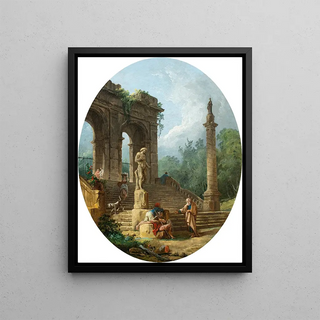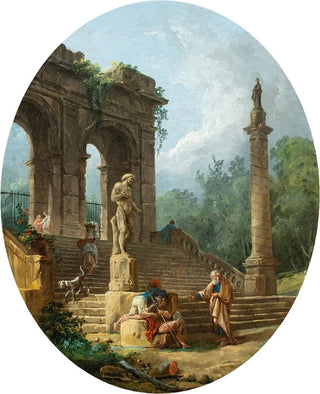Art print | An whim of a classical arcade and a column with characters conversing in front of a statue - Hubert Robert


View from behind

Frame (optional)
In the vibrant universe of 18th-century art, Hubert Robert stands out for his ability to capture the very essence of rêverie and imagination. "An art print of a classic arcade caprice and a column with characters conversing in front of a statue" is a perfect illustration of this. This piece, both delicate and evocative, transports us to a world where the past and present meet, where classical architecture blends with scenes of everyday life. The composition, harmonious and balanced, invites the viewer to question the context and stories hidden behind these figures in conversation, thus creating a dialogue between art and observer.
Style and uniqueness of the work
Hubert Robert's work is characterized by a unique style that combines romanticism with an idealized vision of ruins and landscapes. In "An art print of a classic arcade caprice and a column with characters conversing in front of a statue," the artist plays with light and shadow to bring to life a scene that seems both timeless and anchored in a specific moment. The characters, although static, seem to vibrate with a subtle energy, as if they are about to share a secret. Architectural details, meticulously rendered, demonstrate impressive technical mastery, while the colors, soft and nuanced, create an atmosphere of serenity and contemplation. This work is not just a simple representation; it evokes a feeling of nostalgia and escape, transporting the viewer on a journey through time.
The artist and his influence
Hubert Robert, often nicknamed "the painter of ruins," established himself as a major figure in the French landscape of the 18th century. His training at the Royal Academy of Painting and Sculpture, as well as his travels in Italy, profoundly influenced his art. Drawing inspiration from the great masters of the Renaissance and incorporating elements of nature, Robert created a style that is uniquely his own, blending the sublime with melancholy. His work also had a significant impact on his contemporaries.

Matte finish

View from behind

Frame (optional)
In the vibrant universe of 18th-century art, Hubert Robert stands out for his ability to capture the very essence of rêverie and imagination. "An art print of a classic arcade caprice and a column with characters conversing in front of a statue" is a perfect illustration of this. This piece, both delicate and evocative, transports us to a world where the past and present meet, where classical architecture blends with scenes of everyday life. The composition, harmonious and balanced, invites the viewer to question the context and stories hidden behind these figures in conversation, thus creating a dialogue between art and observer.
Style and uniqueness of the work
Hubert Robert's work is characterized by a unique style that combines romanticism with an idealized vision of ruins and landscapes. In "An art print of a classic arcade caprice and a column with characters conversing in front of a statue," the artist plays with light and shadow to bring to life a scene that seems both timeless and anchored in a specific moment. The characters, although static, seem to vibrate with a subtle energy, as if they are about to share a secret. Architectural details, meticulously rendered, demonstrate impressive technical mastery, while the colors, soft and nuanced, create an atmosphere of serenity and contemplation. This work is not just a simple representation; it evokes a feeling of nostalgia and escape, transporting the viewer on a journey through time.
The artist and his influence
Hubert Robert, often nicknamed "the painter of ruins," established himself as a major figure in the French landscape of the 18th century. His training at the Royal Academy of Painting and Sculpture, as well as his travels in Italy, profoundly influenced his art. Drawing inspiration from the great masters of the Renaissance and incorporating elements of nature, Robert created a style that is uniquely his own, blending the sublime with melancholy. His work also had a significant impact on his contemporaries.






